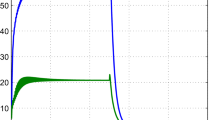Abstract
In this paper we consider the problem of internally and externally stabilising controlled invariant and output-nulling subspaces for two-dimensional (2-D) Fornasini–Marchesini models, via static feedback. A numerically tractable procedure for computing a stabilising feedback matrix is developed via linear matrix inequality techniques. This is subsequently applied to solve, for the first time, various 2-D disturbance decoupling problems subject to a closed-loop stability constraint.
Similar content being viewed by others
References
Basile G., Marro G. (1969). Controlled and conditioned invariant subspaces in linear system theory. Journal of Optimization Theory and Applications 3(5): 306–315
Basile G., Marro G. (1982). Self-bounded controlled invariant subspaces: A straightforward approach to constrained controllability. Journal of Optimization Theory and Applications 38(1): 71–81
Basile G., Marro G. (1992). Controlled and conditioned invariants in linear system theory. Prentice Hall, Englewood Cliffs
Bliman P.A. (2002). Lyapunov equation for the stability of 2-D systems. Multidimensional Systems and Signal Processing 13: 201–222
Conte G., Perdon A. (1988). A geometric approach to the theory of 2-D systems. IEEE Transactions on Automatic Control AC-33(10): 946–950
Conte G., Perdon A., Kaczorek T. (1991). Geometric methods in the theory of singular 2D linear systems. Kybernetika 27(3): 262–270
EbiharaY., Ito Y., Hagiwara T. (2006). Exact stability analysis of 2-D systems using LMIs. IEEE Transactions on Automatic Control AC-51(9): 1509–1513
Fornasini E., Marchesini G. (1978). Doubly-indexed dynamical systems: State-space models and structural properties. Mathematical System Theory 12: 59–72
Fornasini E., Marchesini G. (1980). Stability analysis of 2-D systems. IEEE Transactions on Circuits and Systems CAS-27(12): 1210–1217
Gałkowski K. (1996). The Fornasini–Marchesini and the Roesser models: Algebraic methods for recasting. IEEE Transactions on Automatic Control 41: 107–112
Hu G.D., Liu M. (2005). Simple criteria for stability of two-dimensional linear systems. IEEE Transactions on Signal Processing 53(12): 4720–4723
Kar H., Sigh V. (2003). Stability of 2-D systems described by the Fornasini–Marchesini first model. IEEE Transactions on Signal Processing 51(6): 1675–1676
Karamanciog̃lu, A., & Lewis, F. L. (1990). A geometric approach to 2-D implicit systems. In Proceedings of the 29th Conference on Decision and Control. Honolulu, Hawaii, December 1990.
Karamanciog̃lu A., Lewis F.L. (1992). Geometric theory for the singular Roesser model. IEEE Transactions on Automatic Control AC-37(6): 801–806
Leibfritz F. (2001). An LMI-based algorithm for designing suboptimal static \(\mathcal H_2/\mathcal H_{\infty}\) output feedback controllers. SIAM Journal on Control and Optimization 39(6): 1711–1735
Malabre M. (1982). The model-following problem for linear constant (A, B,C, D) quadruples. IEEE Transactions on Automatic Control AC-27(2): 458–461
Malabre M., Kučera V. (1984). Infinite structure and exact model matching problem: A geometric approach. IEEE Transactions on Automatic Control AC-29(3): 266-268
Malabre M., Martínez-García J., Del-Muro-Cuéllar B. (1997). On the fixed poles for disturbance rejection. Automatica 33(6): 1209–1211
Marro, G., Morbidi, F., & Prattichizzo, D. (2007). H 2-pseudo optimal model following: A geometric approach. In Proceedings of the 3rd IFAC Symposium on System Structure and Control. Foz do Iguaçu, Brasil, October 17–19, 2007.
Morse A.S. (1973). Structure and design of linear model following systems. IEEE Transactions on Automatic Control AC-18(4): 346–354
Paraskevopoulos P.N. (1979). Exact model matching for 2D systems via state feedback. Journal of the Franklin Institute 308: 475–486
Roesser R.P. (1975). A discrete state-space model for linear image processing. IEEE Transactions on Automatic Control AC-20(1): 1–10
Sebek M. (1983). 2-D exact model matching. IEEE Transactions on Automatic Control AC-28(2): 215–217
Wonham W.M., Morse A.S. (1970). Decoupling and pole assignment in linear multivariable systems: A geometric approach. SIAM Journal of Control 8(1): 1–18
Zhou T. (2006). Stability and stability margin for a two-dimensional system. IEEE Transactions on Signal Processing 54(9): 3483–3488
Author information
Authors and Affiliations
Corresponding author
Rights and permissions
About this article
Cite this article
Ntogramatzidis, L., Cantoni, M. & Yang, R. A geometric theory for 2-D systems including notions of stabilisability. Multidim Syst Sign Process 19, 449–475 (2008). https://doi.org/10.1007/s11045-007-0046-8
Received:
Revised:
Accepted:
Published:
Issue Date:
DOI: https://doi.org/10.1007/s11045-007-0046-8




